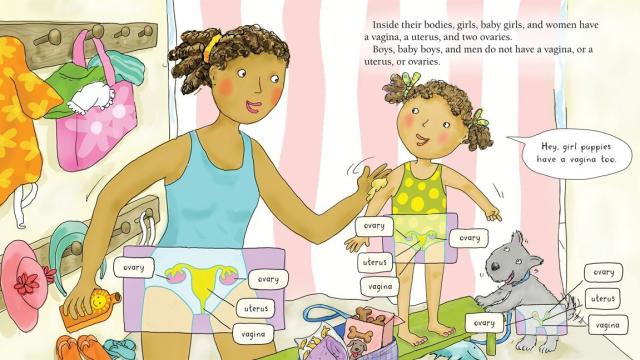An anonymous mother wrote a piece for Today titled “How to Imagine the Unimaginable”. It’s the type of story that as a parent, you can’t bear to read, which means that you must (though do be warned that it deals with sexual abuse).
From the book Who Has What?: All About Girls’ Bodies and Boys’ Bodies by Robie H. Harris.
She details how she discovered that a babysitter had played a game called “privates” with her six-year-old son. The whole thing is horrifying, the type of thing makes you think “never, ever, ever my kid“, and yet as the author points out, one in three girls and one in six boys will be the victim of child sexual abuse by the time they’re 18.
In the end, the author gives a ton of excellent advice for parents on how to help protect their kids. You should read it all. One tip that struck me was the simple reminder to teach your kids the anatomically correct names for their body parts. Vulva. Penis. Anus. Say them aloud.
As Laura Palumbo, a prevention specialist with the National Sexual Violence Resource Center (NSVRC), tells The Atlantic, using what linguists call “standard” dialect for body parts, rather than euphemisms and colloquialisms, “promotes positive body image, self confidence, and parent-child communication; discourages perpetrators; and, in the event of abuse, helps children and adults navigate the disclosure and forensic interview process”.
And as the anonymous Today author adds: “To your child, learning those words is no different than learning your elbow is the part of your arm that’s pointy.”
Sure, it’s natural to be a little squeamish when saying these words to a child. Less than a decade ago, The Guardian published a piece titled “How to Find an Acceptable Word for Your Daughter’s Genitals” – a crowdsourced story that that offered the suggestions of “yoni”, “snooky”, “ladybits”, “pom-pom”, “Doris” and “sparkly bits” (really, wow).
My mother always referred to my vagina as my vagina, but I cannot recall my father ever uttering the word. Dads need to get comfortable with the female terms, too.
If you need some guidance, a book that has been recommended by the Today author and many other parents is It’s Not the Stork!: A Book About Girls, Boys, Babies, Bodies, Families and Friends by Robie H. Harris. It gives straightforward answers to common kid questions: Where do babies come from? Why are some parts of girls’ and boys’ bodies the same and why are some parts different? Harris’ Who Has What?: All About Girls’ Bodies and Boys’ Bodies (pictured above) is also great.
Using cutesy nicknames can suggest that to kids their genitals are something shameful. They are not. Your son has a penis, not a wee-wee. Your daughter has a vulva, not sparkly bits.

Comments